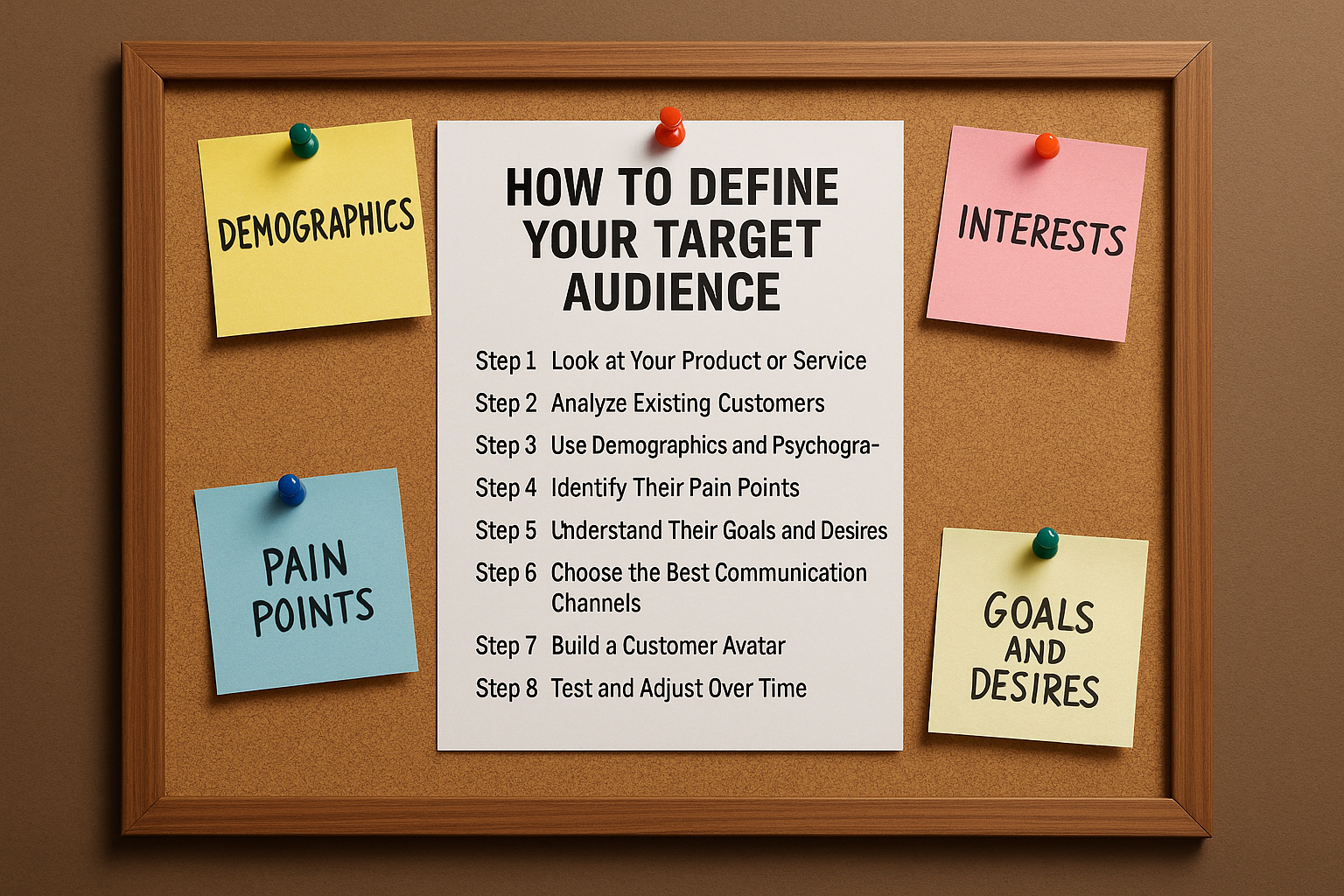One of the biggest reasons small businesses fail to grow is unclear messaging — and that often comes from not knowing who you’re speaking to. Defining your target audience is one of the most important things you can do for your business, especially in the early stages.
Instead of trying to reach “everyone,” the most successful entrepreneurs focus on reaching the right people — those who actually need and want what they offer.
In this guide, you’ll learn how to define your target audience clearly and practically, so your marketing becomes more effective, your products more relevant, and your sales easier to make.
What Is a Target Audience?
Your target audience is a specific group of people most likely to buy your product or service. They share similar characteristics like:
- Demographics (age, gender, income, location)
- Psychographics (lifestyle, values, attitudes)
- Interests and behaviors
- Specific needs or challenges
Example:
A target audience for a productivity app might be:
“Freelancers between 25–40 who work from home and struggle with time management.”
When you define this group clearly, everything else — from your website to your social media content — becomes easier and more strategic.
Why Defining Your Audience Matters
Trying to serve everyone usually leads to:
- Generic content
- Confusing offers
- Wasted marketing budget
- Poor engagement
On the other hand, when you know exactly who you’re serving, you can:
- Create more relevant content
- Speak their language
- Build trust faster
- Sell more easily
- Build a loyal community
Marketing becomes targeted, efficient, and more profitable.
Step 1: Look at Your Product or Service
Start with what you offer. Ask:
- What problem does it solve?
- What need does it fulfill?
- Who benefits the most from it?
Example:
If you offer a bookkeeping service, your ideal audience might be small business owners or freelancers who hate dealing with finances.
The goal is to align your product with a real and specific need.
Step 2: Analyze Existing Customers (if any)
If you’ve already had some customers or clients, study them:
- Who buys from you most often?
- What do they have in common?
- Where did they find you?
- Why did they choose your business?
Even a handful of clients can give you great insight.
If you’re just starting, look at similar businesses in your niche and see who follows them, comments, or engages.
Step 3: Use Demographics and Psychographics
Demographics:
- Age
- Gender
- Location
- Education
- Marital status
- Occupation
- Income
Psychographics:
- Interests and hobbies
- Life goals and dreams
- Core values
- Personality traits
- Daily habits
- Pain points and fears
Example Audience Profile:
“Maria, 35, lives in a big city, works as a freelance designer, earns $40k/year, values creativity and independence, spends time on Instagram and YouTube, and often feels overwhelmed by client deadlines.”
The more detailed, the better.
Step 4: Identify Their Pain Points
Understanding what frustrates your audience is key to connecting with them emotionally.
Ask:
- What’s keeping them up at night?
- What are they afraid of?
- What have they tried that didn’t work?
- What do they wish existed?
This is where empathy wins. You’re not just selling a product — you’re solving a real-life problem.
Example Pain Point:
“Small business owners are stressed because they waste hours every week doing their own taxes and don’t know if they’re doing it right.”
Step 5: Understand Their Goals and Desires
Besides solving problems, your product or service should help people achieve something.
Ask:
- What does success look like for them?
- What are their short-term and long-term goals?
- What would their life look like after using your solution?
This helps shape your brand message to show transformation, not just features.
Example Desire:
“They want to feel confident and in control of their business finances without spending hours doing spreadsheets.”
Step 6: Choose the Best Communication Channels
Now that you know who your audience is, determine where they spend their time and how they prefer to consume content.
Options include:
- Instagram (great for visuals and lifestyle audiences)
- Facebook (active communities, older demographics)
- LinkedIn (professional and B2B audiences)
- YouTube (educational content and tutorials)
- Email (for deeper, more personal engagement)
- Blogs or podcasts
Focus your efforts where your audience is already hanging out.
Step 7: Build a Customer Avatar (Ideal Customer Profile)
Now, bring everything together into a detailed profile. This will guide all your marketing and product decisions.
Example Avatar:
Name: Jake
Age: 28
Occupation: Freelance web developer
Location: Los Angeles
Pain Points: Struggles to find consistent clients, poor time management, distracted easily
Goals: Grow a stable income, work fewer hours, become known in his niche
Habits: Spends time on Reddit, listens to podcasts while working, follows productivity accounts on YouTube
Keep this profile visible when you create content, ads, or product features.
Step 8: Test and Adjust Over Time
Audience definitions evolve. As your business grows, you’ll learn more and might shift directions.
Keep an eye on:
- Who engages with your content
- What gets the most clicks, shares, or responses
- What products or services sell best
- What feedback you receive
Don’t be afraid to adjust your focus as your business and customer base evolve.
Final Thoughts: The Right People Make All the Difference
You don’t need to appeal to everyone — you just need to connect deeply with the right people.
When you define your target audience clearly, every decision becomes easier: what to create, what to say, where to show up, and how to grow.
So take the time now to define your audience with intention — it’s one of the smartest moves you can make as a small business owner.
